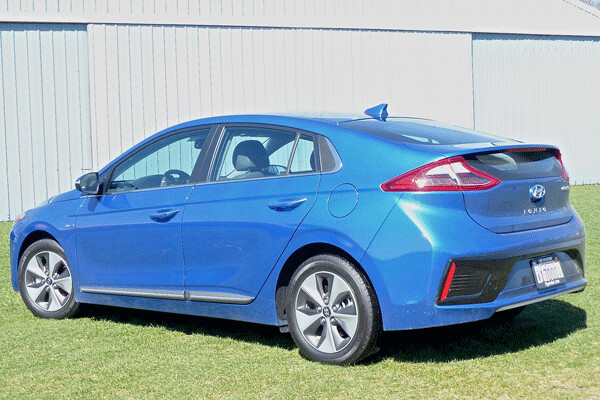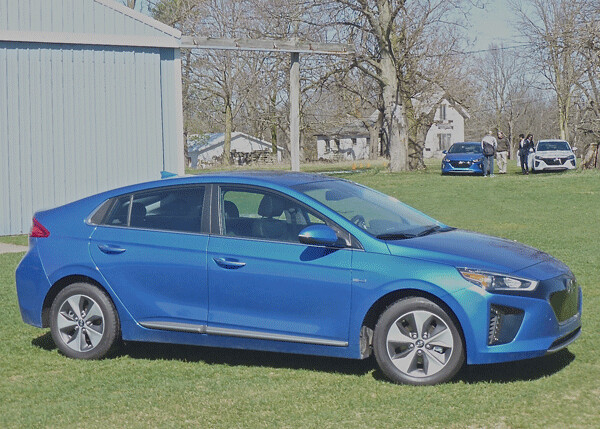Hyundai Ioniq more than just another hybrid

ANN ARBOR, MI.
If the Hyundai Ioniq came out as a mainstream compact car with its sleek and aerodynamic lines, roomy interior, quick and agile performance and smooth ride, it would undoubtedly be a big hit at a base price of $22,200.
But it’s not a mainstream car. Far from it. It is a unique vehicle designed to be sold in a choice of three alternative powertrains, and after a brief but aggressive chance to road-test the Ioniq, I would say the impression it leaves is — in a word — electrifying.
For many consumers, apprehensions from preconceived ideas get in the way of buying a hybrid vehicle, much less a pure-electric one. Hyundai officials are aware of all the reasons buyers have for NOT buying such an alternative-energy car, and designed the Ioniq to conquer all of them.
The Ioniq is the first car with a dedicated platform designed to offer the choice of three high-tech alternative-energy powertrains -- the most efficient hybrid in the industry, the most progressive plug-in hybrid in the industry, and the most environmentally sound and efficient pure-electric car in the industry.That’s a lot of firsts, but ever since it made a technical breakthrough in engine, transmission and design development nearly a decade ago, we shouldn’t be surprised by what the dedicated Hyundai engineers in Seoul, South Korea, can come up with.
“The best thing is it looks like a regular car, and it drives like a regular car,” said Mike O’Brien, vice president of products for Hyundai Motors America.
I beg to differ. When my driving partner and I took off on the less than smooth and twisty roadways near Ann Arbor, we drove harder than a normal citizen might drive, because we wanted to push the Ioniq to see if it was just another alternative-energy car or truly something special. My vote was the latter. If I didn’t know what was under the hood, I would have been impressed that the Ioniq swept around tight, even blind, curves, always with the car following with dutiful discipline to any and all precise steering inputs. It stayed level, never lurched, and it handled the numerous road irregularities we flew across with nary a jolt of harshness.

When my turn was finished, I found the passenger bucket supportive and comfortable in all circumstances, and it gave me a better chance to admire the smooth and high-end look and feel to the seats, dashboard and numerous features. They use wood chips and bits of volcanic rock to make the soft and supple top on the dashboard, and they found a way to mix soybean oil into the paint.

We were driving the top-end, pure-electric version of the Ioniq, which will start at $29,500 and will have no gas-engine safety net, but will have a range of 124 miles before needing a recharge. It does have a larger electric motor system, and a potent version of the LG Chem battery pack that develops 88 kW, the equivalent of 118 horsepower and 218 foot-pounds of torque, which collaborate to send the car rocketing away from a stop with startling potency.
There are other dazzling EVs on the market, such as the Tesla, the Chevrolet Bolt, Nissan Leaf, and BMW i3. The Bolt has a range of 238 miles, which is very impressive, and the Tesla also has excellent range. O’Brien, however, referred to a thermal efficiency calculation, which takes into account such things as the carbon footprint, which figures in that 67 percent of our electric energy comes from fossil fuel or coal. So electric power seems free, but nothing is free.
“Ultimately, we’re going to have to reduce our carbon footprint,” O’Brien said. “They call it an ‘MPGe’ equivalent, and the Ioniq is the most efficient EV with a 136 MPGe, which beats the i3, the Bolt, and all other EVs on the market.”

Before we took off on our drive, O’Brien explained the assets of the three-pronged answer to all the alternative-energy challenges. He started off by enumerating the challenges.
“Those who choose hybrids or electric vehicles are only 3 percent of all buyers,” said O’Brien. “We seem to be stuck on that number. The reasons consumers give for avoiding hybrids are: cost, lack of performance, boring, maintenance worries, not sporty enough, and insufficient passenger or cargo room.


“When you look under the hood of a Camry or Accord hybrid, you see all kinds of extra space, which is because the platform was designed for a larger engine. With a dedicated platform, and using a small engine with the hybrid means we didn’t need all that space, so we moved the cowl forward, creating a much more spacious interior. Our hybrid has a total interior volume of 122.7 cubic feet, and our plug-in hybrid and EV have 120 cubic feet.”
In addition, Hyundai worked with LG Chem, the South Korean electronics giant that designed and built the battery pack for the Chevrolet Volt, and the new Chevrolet Bolt pure-electric, as well as for Hyundai, Kia and other hybrid car-makers. The streamlined design, with vertical plates, and a lithium ion polymer structure, are lighter and smaller and can form-fit to an odd area, but they charge more quickly turn out more power, and recharge more quickly.
Other hybrid car-makers fit the battery pack under the trunk, which greatly cuts down the cargo room, and, being heavy, also give most hybrids an odd weight-distribution. Hyundai engineers designed the Ioniq with the battery pack under the rear seat, creating a lower center of gravity, and adding a mid-engine feel that enhances steering and contributes to good handling.
Hyundai engineers also revised their well-proven 1.6-liter Kappa 4-cylinder, a dual-overhead-camshaft gem with direct injection that can make compact cars, midsize cars, and even the Tucson compact SUV perform admirably, with a turbocharger in some cases. In the Ioniq, it is altered with Atkinson-cycle technology that keeps the intake valves closed a bit longer, and delays the opening of the exhaust valves. That allows the air-fuel mixture more time to more fully ignite and results in greater thermal efficiency, if not extra power. With the hybrid, it doesn’t need extra power, because the electric motor supplements any need for power.
In the Ioniq Hybrid, the 1.6 has 104 horsepower at a high 5,700 RPMs, and 109 foot-pounds of torque at 4,000 RPMs. The electric motor adds 32 kW (43 horsepower) for a 125 horsepower maximum, and its 125 maximum added torque combines for a 139 foot-pound punch.
It’s hard for some traditionalists to realize that electric motor power is more efficient than a gas engine. It has 100 percent of its torque at zero RPMs, so stepping hard on an electric car’s “gas” pedal can snap your head back by surprise. In the Ioniq, the electric motor’s instant torque aids low-end power, and if you need extra power at high speed, the electric power can continue to supplement the 4-cylinder up to 75 miles per hour.
We also drove the base-model hybrid, and while we regretted not having the optional navigation system’s route-following efficiency, it also drove well, with quick acceleration, and good steering and handling. Unlike nearly all other hybrids, the Ioniq Hybrid does not use a CVT, the continuously variable transmission that uses belts and pulleys to seamlessly shift, but leaves the unsatisfying feeling of “motorboating” instead of tangible shift points.
Hyundai engineers equipped the Ioniq with their own 6-speed dual-clutch transmission that shifts swiftly and with a decisive sportiness, whether you like paddles or just switching to “sport” to hold shift points higher. The “eco” setting upshifts earlier for better economy, and the Ioniq Hybrid comes away with everyday fuel economy of 59 highway, and 58 mpg combined city-highway. That beats the Prius and all other hybrids, as does the Ioniq’s thermal efficiency that means 40 percent of all its energy goes to its wheels, which are shod with specially designed Michelin tires.
We didn’t get to drive the plug-in hybrid, which is yet to be introduced as the third electrified system. That will move up from the Hybrid’s 32 kWh with 43 horsepower, to 45 kWh, and 60 horsepower. With more electric motor power in the mix, when fully charged it will go 27 miles on electric only, before the gas engine needs to help.
Both hybrids share the 6-speed dual-clutch transmission. The plug-in Hybrid has a more powerful charger. You can connect to normal household outlets, but if you use the quick-charge system you can recover 80 percent of a full charge in 23 minutes, a fast charge that will let you cover another 99 miles.
All available safety items, including standard rear camera, and the availability of lane-change devices, are included, and the Ioniq also has all the latest in connectivity items.
I am eager for a longer test-drive, but the first impression will be hard to shake. The Ioniq beats the tests of cost, sportiness, being not boring, not sporty, and having insufficient interior room. If maintenance worries still exist, how about this: Along with Hyundai’s usual 10-year, 100,000-mile engine warranty, there is a lifetime warranty on the battery pack.
I kidded O’Brien that if the Ioniq doesn’t quite meet fuel-efficiency figures, they could come out with a Type R and insert a tiny “R” between the “I” and the “O” and make it an “Ironiq.” He didn’t laugh. After driving the car, I’m more inclined to suggest they might need to insert a small “C,” because the new car could indeed become Iconiq.

